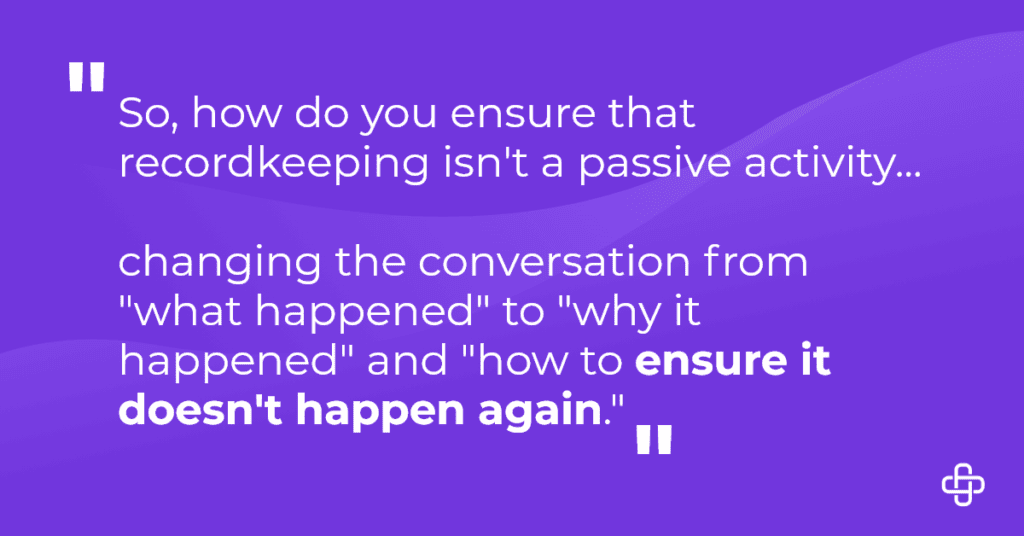Have you ever considered diligent recordkeeping’s profound impact on ensuring a safer workplace?
Health and safety in the workplace are not just buzzwords; they’re the bedrock of any thriving company.
For most employers and employees, the Occupational Safety and Health Administration (OSHA) is an omnipresent force—a guardian of well-being that sets the benchmark for what constitutes a safe working environment.
However, OSHA isn’t just about setting regulations; it’s also about recordkeeping—meticulously tracking incidents and maintaining an organizational memory of what’s happened and how it was addressed.

The Anatomy of OSHA Recordkeeping
Before we can understand the impact of meticulous recordkeeping, it’s crucial to define what in fact, OSHA recordkeeping entails.
OSHA requires employers to log all work-related injuries and illnesses, maintaining those records for a minimum of five years. These records not only serve to document what’s occurred but also identify trends in workplace hazards and how they materialize.
What Counts as a Recordable Incident?
The litmus test for OSHA recordability is straightforward. An injury or illness must be work-related, result in one or more of the following criteria, and meet specific criteria:
- Death
- Days away from work
- Restricted work or transfer to another job
- Medical treatment beyond first aid
- Loss of consciousness
- A significant injury or illness diagnosed by a physician or other licensed health care professional.
Employers must use OSHA Form 300, OSHA Form 301, or equivalent forms to capture these incidents.
Why Drastic Accidents are the Tip of the Iceberg
It’s easy to fixate on major accidents, but in truth, these represent a fraction of workplace health and safety issues. Many small injuries or near misses go unrecorded or underreported.
However, when you add up these seemingly innocuous incidents, they often reveal systemic issues that, left unchecked, can fester into more substantial problems.
The Ripple Effect of Inaccurate Recordkeeping
Relaxed recordkeeping hinders safety improvements. Misclassified incidents mislead safety efforts, risking employee safety.
The Problem with Leading Indicators: Leading indicators predict future risks better than lagging ones. Underreporting minor incidents hides important signals of hazards, jeopardizing safety.
The Cost of Ignorance: Neglecting accurate records can damage a company’s reputation, incur fines, and most importantly, lead to preventable injuries.
Spotlight on Compliance and Competence
Compliance with OSHA regulations is crucial for protecting your business. Approach recordkeeping with competency, investing in systems ensuring strict adherence to standards.
Bridging the Standard-and-Practice Gap: Knowing rules vs. implementing them daily is a challenge. Addressing this gap is vital to prevent accidents and legal issues.
Invest in Expertise: OSHA-Compliant Personnel: Train internal OSHA experts to bridge the gap. Concentrated knowledge leads to a safer organization. It’s an investment in your safety culture.
Bridging the Gap: Improving Workplace Safety Through Recordkeeping
So, how do you ensure that recordkeeping isn’t a passive activity but rather a pivot for enhancing safety? It’s about changing the conversation from “what happened” to “why it happened” and “how to ensure it doesn’t happen again.”
Visibility and Review
The first step is to bring recordkeeping out of the back office and into the light. Make these records visible, and more importantly, review them regularly. Treat this data with the same rigor you’d give to sales figures or production targets.
- The Power of Trend Analysis: Trends are the story arcs of your safety narrative. Is there a spike in a certain kind of injury? Are particular departments or shifts more accident-prone? Acknowledging these trends is the first step in addressing underlying safety issues.
- The Regular Safety Huddle: Just as the sports team reviews tape to learn from their performance, so too should your safety team meet regularly to review incidents. This isn’t about pointing fingers; it’s about shared learning and collective responsibility.
Proactive Policies and Training
Don’t wait for the next incident to correct the course. Proactive policies and training that target common issues can serve as a preemptive strike against future incidents.
- Preventive Maintenance: Sometimes, it’s as simple as keeping tools in top shape or ensuring the workplace is well-organized. These practices, captured in recordkeeping, can serve as a checklist for preventive actions that keep safety top-of-mind.
- Continuous Education: Employees are the frontline soldiers of your safety regime. Regular training serves to both inform and empower them, fostering an environment where everyone is invested in safety.
Axiom Medical: Your Compliance and Safety Partner
The vision of Axiom Medical is simple yet innovative—to integrate workplace environmental and employee health management into a seamless, data-driven solution. With our suite of services, we’re not just a provider; we’re a partner in your safety mission.
Industry-Leading Reporting and Data Analysis
Axiom’s reporting isn’t just about numbers; it’s about narrative. Their sophisticated data analysis tools help you see beyond the surface, identifying trends and outliers that might not be immediately visible in raw data.
Certified Medical Professionals On-Demand
OSHA compliance isn’t just about paperwork; it’s about people’s well-being. Axiom’s 24/7 nurse triage and telehealth services put licensed medical professionals at your employees’ fingertips, turning compliance into compassionate care.
Streamlined Program Management
Safety isn’t a one-off; it’s a continuum. Axiom’s tools help you find the signal in the noise, making sense of your compliance efforts and ensuring nothing slips through the cracks.
Conclusion: The Pursuit of Perfection
Perfect safety is an ideal for which we strive. Meticulous recordkeeping, actions from reports, training, and safe workplace design bring us closer.
Accurate OSHA recordkeeping is a commitment to employees’ safety and well-being. With the right partner, this commitment becomes a reality and a catalyst for change. Our records are a map for the future, guiding us toward a safer workplace.
Ready to elevate your safety standards? Check out our free Introduction to OSHA: A Guide to Workplace Safety, now!










